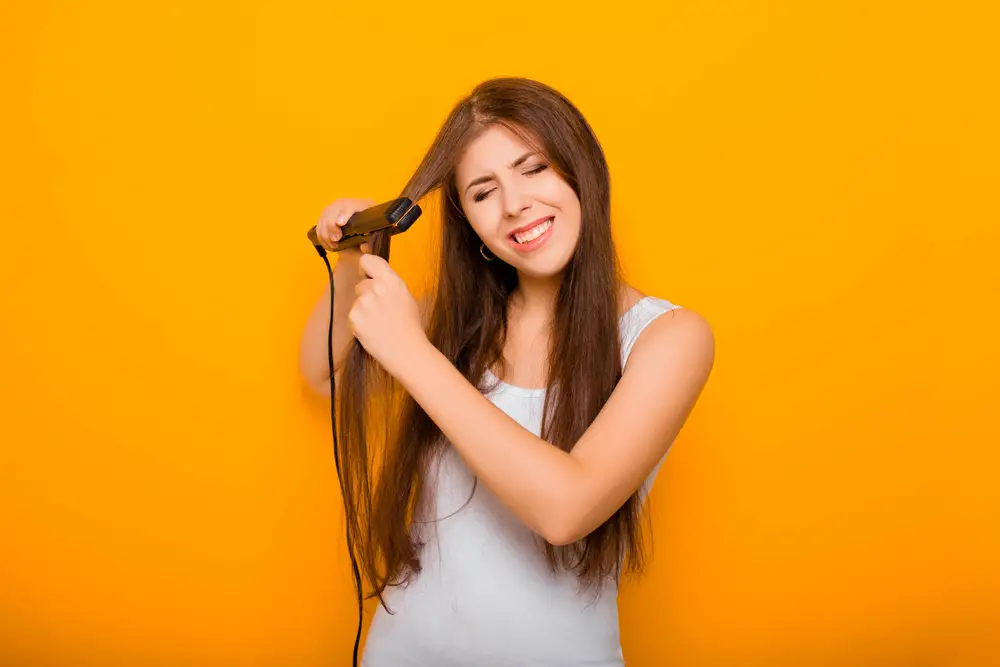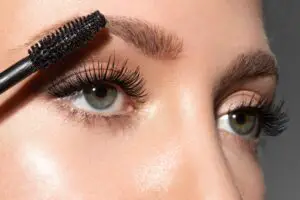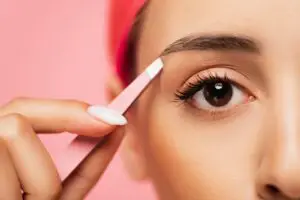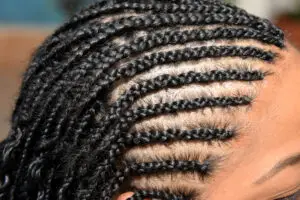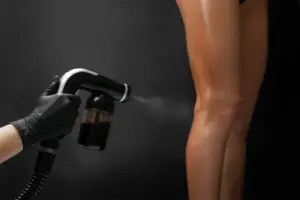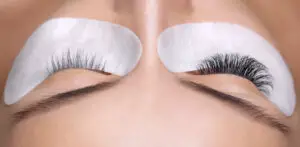Having sleek, straight hair can be an enviable attribute for those who constantly battle with unintended curls at the ends of their locks.
This common occurrence often happens due to humidity, hair texture, or styling habits, and it can be incredibly frustrating when you’ve dedicated time to achieving that straight look only for it to be sabotaged by unruly tips.
Fortunately, there are methods available to prevent your hair from curling up at the ends and maintain a flawless, smooth finish.
To understand how to stop your hair from curling at the ends, it’s essential to know the potential causes. Factors such as heat styling, hair products, and washing habits can all contribute to those unwanted curls.
By identifying the source of the issue, you’ll be better equipped to make the necessary changes in your hair care routine and achieve the desired results.
In this article, we’ll share some easy-to-follow tips that can help put an end to pesky curled ends.
From adjusting your hair care routine and using the right hair products, to mastering straight hair styling techniques, we will provide solutions to help you achieve and maintain sleek, straight hair without the unwanted curls. Follow these strategies and banish those bothersome bends for good.
Understanding the Causes of Hair Curling
There are several factors that can lead to hair curling at the ends. By understanding these factors, you will be better equipped to prevent and manage unwanted curls.
This section will discuss genetics, hair damage and environmental factors as the primary causes of hair curling.
Genetics
Genetics play a significant role in determining your hair type and texture. Some individuals naturally have curly or wavy hair due to the shape of their hair follicle.
If your parents or close relatives have curly hair, it is more likely that you will also experience hair curling at the ends.
Hair Damage
Over time, hair can become damaged due to various factors, including:
- Heat styling tools: Frequent use of hair dryers, straighteners, or curling irons can cause hair to lose moisture and become prone to breakage, which can result in curling at the ends.
- Chemical treatments: Hair colouring, perming, or relaxing treatments can weaken the hair structure, making it more susceptible to damage and curling at the ends.
- Rough handling: Brushing your hair aggressively or using abrasive hair accessories can lead to fraying and curling ends.
Environmental Factors
External elements can also play a part in causing your hair to curl at the ends:
- Humidity: High levels of humidity can cause the hair to absorb moisture from the air and swell, resulting in frizz and curling at the ends.
- Dryness: A lack of moisture can make hair brittle and more prone to breakage, leading to curling at the ends.
- UV exposure: Prolonged exposure to the sun’s UV rays can weaken hair and cause it to become more susceptible to curling at the ends.
To minimise the effects of these environmental factors, consider using protective hair products and adapting your hair care routine accordingly.
Hair Preparation Techniques
Shampooing and Conditioning Properly
Choosing the right shampoo and conditioner for your hair type is essential for preventing unwanted curling at the ends. Opt for sulphate-free shampoos, as they are gentler on the hair and help to maintain its natural moisture.
Switch to a conditioner with smoothing and straightening properties to give your hair the necessary nutrients and moisture it requires.
- Wash your hair every 2-3 days to prevent dryness.
- Apply conditioner only on the lengths and ends of your hair, avoiding the scalp.
- Rinse thoroughly with cold water to seal the hair cuticle and reduce frizz.
Using a Heat Protection Spray
Heat styling tools can lead to hair curling at the ends. To safeguard your hair from heat damage, make sure to use a heat protection spray before any type of heat styling.
- Apply the heat protection spray uniformly on your damp or dry hair.
- Use a comb to distribute the product evenly throughout your hair.
- Wait for a few seconds to let the spray absorb before styling your hair.
Brushing Techniques
Improper brushing techniques can cause hair breakage and contribute to curling at the ends. Follow these tips to brush your hair effectively:
- Use a wide-tooth comb or a paddle brush for detangling and spreading products.
- Start from your ends and work your way up to the roots to prevent breakage.
- Brush your hair gently, in slow strokes, to avoid causing any damage.
By incorporating these hair preparation techniques, you can efficiently reduce the likelihood of your hair curling at the ends while maintaining its health and appearance.
Straightening Tools and Techniques
Using a Flat Iron
A flat iron is a versatile hair tool that can create both straight and curly styles. To prevent your hair from curling at the ends, follow these steps:
- Heat the flat iron to the appropriate temperature for your hair type. Fine hair should use the lowest setting, while thick, coarse hair may require higher temperatures.
- Apply a heat protectant spray to your hair.
- Section off your hair for easier straightening.
- Use the flat iron in a smooth, downward motion, ensuring the ends are fully straightened.
Blow-Drying with a Round Brush
Blow-drying your hair with a round brush can help to straighten your hair and prevent curls. Here’s how:
- Apply a heat protectant spray and a straightening serum to damp hair.
- Detangle and divide your hair into manageable sections.
- While holding the round brush, stretch your hair straight and follow with the blow dryer, pointing the nozzle downwards.
- Ensure the ends are straightened and completely dry for a smooth, straight finish.
Hair Rollers and Wraps
Hair rollers and wraps can be an alternative method for achieving straight hair without the need for excess heat. Here are some steps to follow:
- For hair rollers:
- Apply a straightening serum to damp hair.
- Start at the roots and tightly wrap sections of hair around large rollers.
- Allow your hair to dry completely before removing the rollers.
- For hair wraps:
- Apply a straightening serum to damp hair.
- Divide your hair into sections and wrap each one around your head, using clips or bobby pins to secure it in place.
- To speed up the process, use a hair dryer on a low heat setting or wear a hair wrap overnight.
Remember to use the appropriate tools and techniques for your unique hair type to achieve the best results in preventing your hair from curling at the ends.
Preventive Measures
Regular Hair Trims
Keeping your hair healthy is one of the best ways to stop it from curling at the ends. Regular hair trims are essential in maintaining healthy hair.
Experts recommend getting your hair trimmed every 6-8 weeks. This helps to remove split ends and prevent any breakage, which in turn reduces the chances of hair curling at the ends.
Deep Conditioning Treatments
Another vital step in preventing hair from curling at the ends is deep conditioning. Deep conditioning treatments help to nourish and protect your hair, maintaining its integrity and health.
Aim to use deep conditioning treatments at least once a week, focusing specifically on the ends. This will help to:
- Keep your hair hydrated and nourished
- Reduce the risk of hair damage
- Maintain hair elasticity and strength
Protecting Your Hair from Heat and Sun Damage
Exposure to heat and the sun’s UV rays can also be a significant cause of hair curling at the ends. It is essential to protect your hair from heat and sun damage. Here are some ways to shield your hair:
Heat protection products: Essential when using heat styling tools like straighteners, curling irons, and hair dryers. Apply a heat protection spray or serum on your hair before using heat devices to minimize heat damage.
Sun protection: Sun exposure can damage your hair, leaving it dry and prone to curling at the ends. Use hair products with UV protection and cover your hair with a hat or scarf when spending extended periods outdoors.
Embracing Your Natural Hair Texture
Learning to embrace your natural hair texture can be a liberating experience. Instead of constantly battling against it, accepting and working with your hair can lead to healthier, happier locks. Here are some tips on how to embrace your natural hair texture:
First and foremost, it’s essential to identify your hair type. There are several types of hair textures, including straight, wavy, curly, and coiled. Knowing your hair type will help you understand how to care for it properly and prevent the ends from curling uncontrollably.
- Straight hair: This type of hair tends to be smooth, sleek, and can become greasy quite easily. Regular washing and conditioning are vital for maintaining healthy straight hair.
- Wavy hair: Characterised by an S-shaped pattern, wavy hair can range from loose waves to more defined curls. Hydration and frizz control are essential for keeping wavy hair in check.
- Curly hair: Curly hair comes in various patterns, from loose ringlets to tight spirals. Regular deep conditioning and using sulfate-free shampoos will help maintain the natural curl pattern.
- Coiled hair: This type of hair is dense, has a high level of shrinkage, and is prone to dryness. Moisturising products and gentle detangling methods are key for caring for coiled hair.
To stop your hair from curling at the ends, you can adopt a few habits suitable for your hair type:
- Get regular trims: Keeping your hair well-trimmed can prevent split ends and keep your hair healthy. Aim to schedule a trim every 6-8 weeks, depending on your hair type and condition.
- Avoid heat styling tools: Excessive use of heat styling tools such as straighteners, curling irons, and blow dryers can damage your hair and cause the ends to curl. Instead, allow your hair to air dry and embrace its natural texture.
- Use gentle brushing techniques: Be cautious when brushing your hair, as being rough can cause breakage and curling at the ends. Invest in a high-quality brush designed for your hair type, and always brush gently to avoid damage.
- Moisturise and nourish: Keep your hair well-hydrated by using deep conditioning treatments and hair oils suited for your hair type. Maintaining proper moisture levels can help prevent the ends from curling.
- Protect your hair from environmental damage: Sun, wind, and pollution can all impact your hair’s health, leading to curling at the ends. Use protective products like sunscreens and hats to shield your hair from harmful elements.
By understanding and working with your natural hair texture, you can achieve healthier, happier locks that showcase your unique beauty.

I’m Jennifer a beauty and wellness expert. I believe in promoting a sustainable and healthy lifestyle from within. Helping people feel good is my passion; whether it’s teaching yoga or offering skincare advice.

